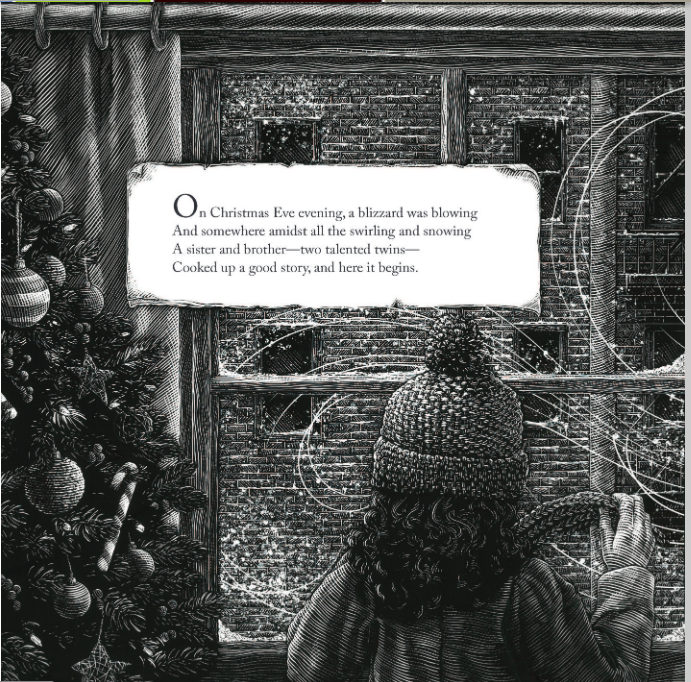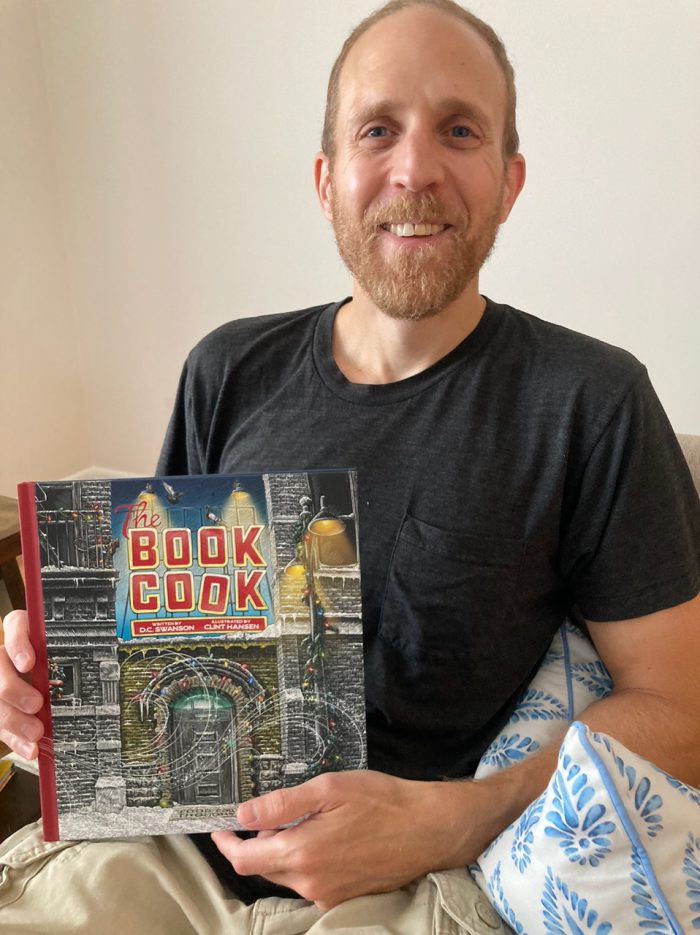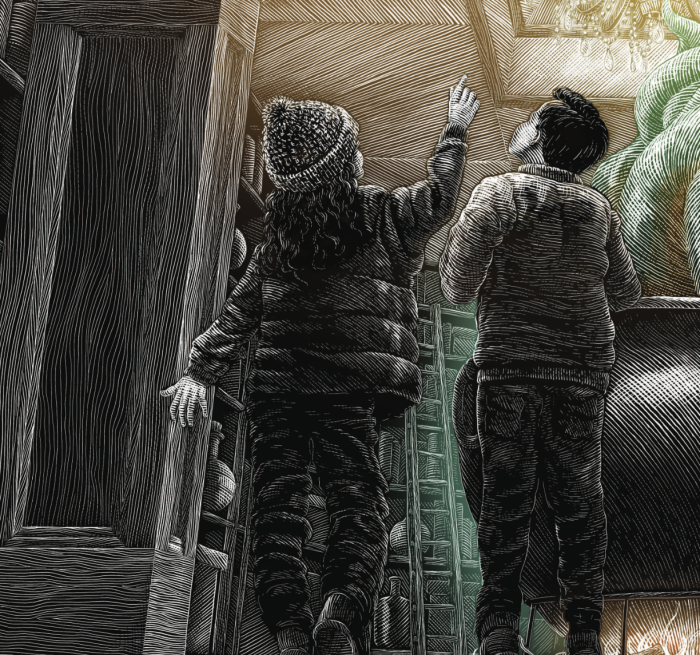You can’t cross a creek
if you drift with the tide;
when boating, like voting,
you must pick a side.
The above is an excerpt from D.C. Swanson’s X account, a rhyming diary of thoughts and anecdotes often in short, four-line form. This poem, in particular, must have been inspired by something quite personal to the owner of the account, considering that D.C. Swanson spent 17 years working on Capitol Hill as a Counsel to the Senate Judiciary Committee – where picking a side on issues can prove much more complicated than crossing a creek.
Swanson, whose real first name is Dan, recently left the political world and published his first children’s book: The Book Cook. The Christmas story is meant to encourage kids to read more – and, of course, to never procrastinate when it comes to giving gifts to your mother!
Swanson spoke with CreativeFuture about his career as a Senate staffer, and how he made the leap from policymaking to storytelling – with a little help from his two daughters.
JC TAYLOR: You had this long career working alongside Senator Dick Durbin, and now you’re pursuing this creative endeavor. Can you tell me about how you first got interested in politics?
DAN SWANSON: I had been an intern in Congress way back in 1999 and caught the political bug there. Even then, I hoped that I would someday become a counsel on the Senate Judiciary Committee. After law school, I worked at a law firm for a few years before taking an 85% pay cut and coming to work for Senator Durbin in 2006 as a legislative correspondent (LC).
Very quickly, my office gave me assignments on Judiciary Committee issues. After a year as an LC, they moved me over to Committee staff, where part of my portfolio included copyright and intellectual property. So, I had a chance to work on those issues for over 17 years, which was great.
My creative work started when I was young and continued on when I was working for Senator Durbin. I was a night writer, just writing whenever I got a chance after my day job was done. But during the day, I had the opportunity to work on these significant creative issues from a policy perspective, which was fascinating to me.
JC: A lot of our readers won’t know this, but your work as a staffer is incredibly important and is essentially what keeps the country running. So, tell us what your day-to-day looks like working as a Counsel for the Senate Judiciary Committee.
DS: The Senate Judiciary Committee is one of the busiest committees in Congress.
It has a broad jurisdiction covering a wide range of issues, including the Supreme Court and other court nominations, criminal justice issues, civil justice issues, and a whole host of contentious, partisan issues.
It also covers intellectual property, which is one of the issues that has a long history of bipartisan cooperation. But it is still a complex issue. Some of the bills we worked on took years. When the Senate is in session, you’re holding hearings multiple days a week, you’re voting on bills and nominations in committee, and then you’re – hopefully – getting bills and nominations to the floor.
It’s very hard work, and very long hours. But it’s very satisfying when you can get something through – when you’re able to build a coalition in support of a reform and you’re able to pass it, fund it, enforce it, and have it do some good. And it was an honor to work for Senator Durbin, who is just an outstanding public servant. He was a great boss.
JC: Did you find that you had to wear a lot of hats, or were you able to pick a lane and focus on one specific area?
DS: Everything was a team effort in our office, but usually, each staffer would have an issue or a set of issues for which they were the primary staffer. In the Senate, you have to get bipartisan buy-in in order for things to move, so a lot of the work is spent trying to find a partner on the other side of the aisle who can help move things along.
Some of the legislation I’m proudest of were bills we worked on very closely with Republican offices. For example, we identified areas in copyright law where the law wasn’t working the way it needed to, making it more difficult for creators to make a living and protect their works from infringement. And we got the law changed.
JC: Tell me why you think creative issues were important to you and Senator Durbin.
DS: We often had creators come in to talk about the work they did – often it was well-known work that I was already familiar with – and talk about the challenges of trying to make a living doing that work.
It’s honestly astonishing to hear those stories. It made an impact on me, and on the Senator as well. The stories would really hit you in the gut, when you would hear about people who make amazing creations and were still struggling to pay the bills.
So, we tried to identify areas in which the law was out of date, making people unable to adequately protect their work. That’s what I’ve always told organizations that work on these issues – it’s so important to hear about their personal stories working as creators and the challenges that they face.
JC: Over your 17 years on the Hill, how did things change?
DS: In some ways, work that I started back in 2006 continued, and I was able to keep with it and see how political issues evolved over time. Copyright law was one of those areas that changed.
There were times, at the beginning of my career, where any kind of copyright reform was viewed as a kind of hot potato. Big Tech was critical of some of the proposals that were trying to safeguard against infringement, and there were a lot of people that were scared of going up against Big Tech.
Over time, I was able to see the tides turn in these areas.
JC: Continuing on about change – the first iPhone came out while you were working in Congress. How were lawmakers able to keep up with such rapidly changing technology?
DS: I’m proud that one of the things I was able to do on the Committee was to help explain to people why we had to update the law to accommodate for these new content channels.
I think of the rise of music streaming and how we had to change the law to address it with the Music Modernization Act. With the CASE Act, I think especially of the photographers and visual artists who were facing constant infringement for small-dollar amounts that were really impacting their small businesses. We were able to shift from those misinformed copyright conversations of the early 2010s to a much more reasonable discussion about ways in which we can update the law, and we did it in a bipartisan way.
JC: Tell me a bit about the “night writing” you mentioned earlier. How did you find time for it? How did it start?
DS: It started with reading to my daughters at night before bed. No matter how busy I was, I always tried to carve out time to do that.
Starting with my older daughter, we would read the young baby books up through the older kid books, and at every stage reading those, you start to think, “I wonder if I could try doing this, too.”
When my older daughter was in first grade, we decided to try and write our own story as a family project. I sat down and started writing rhymes and would ask her what she thought about them, and eventually we got to a point where we had a full story. We started sharing that story with family and friends, and they liked it, and eventually we found some people on Twitter who were looking for stories to review and started to get some positive feedback from them, too.
One that really stuck with me were these two retired British female professional wrestlers, The Blossom Twins, who are now authors, and they love Christmas stories. They loved our story, and I really appreciated their feedback. I thought if my first-grade daughter liked the book, and retired pro wrestlers liked it too, there might be something there.
Then, for years, I would periodically send it off to literary agents and publishing companies and nothing would come from it. That went on until 2022, when I sent it to a publisher, Baobab Press in Reno, that liked it and said they wanted to illustrate and publish it. I was thrilled!

JC: So, in 2022, the publisher says they like it, and they want to illustrate it. What happens then?
DS: The publisher knew an artist named Clint Hansen in Iowa. He’s done fantastic work in a whole range of areas, but he had never done a kids’ story before, and he was interested in trying one.
He works with scratchboard, where everything he does is etched into a board with what is essentially a scalpel. It’s very time consuming, but the detail he’s able to put into his illustrations is just astonishing.
We had some very fun brainstorming sessions about the book. I found it surprising to have business meetings about things like putting a cat into every illustration in this children’s book. It was a wonderful process.
JC: It must be cool too to see someone else’s visual representation of your own words.
DS: He’s an outstanding person to work with.
At the outset, my publisher asked me to create a storyboard for the book, and I didn’t even know what a storyboard was.
I’m such a bad artist, I had to get my younger daughter who was only nine years old to help me draw the storyboards. The final book illustrations are pretty similar to what my younger daughter had drawn, so I was thrilled that both of my daughters were able to contribute to the book. But Clint’s artistry is just phenomenal.

JC: So, the book is The Book Cook. What’s it about?
DS: When twin 11-year-olds realize they forgot to buy a Christmas gift for their mother, their father gives them permission to go out on Christmas Eve for some last-minute shopping. They stumble upon a mysterious store where they meet the Book Cook, who takes story ingredients and mixes them together in a big cauldron to make stories come to life. Then the twins accidentally knock over shelves of ingredients into the cauldron, and things get a little crazy.
A lot of what motivated the creation of the book is my desire to encourage my kids to read. I’m trying to get them away from screens, as many parents try to do. The message of The Book Cook, in addition to “Don’t wait until the last minute to buy gifts for your mother”, is to read books, and to try and tell your own stories. Those are messages that I’ve preached to my kids for a long time, but to be able to put those messages into a story with fun illustrations – it was great to do.
I was always careful while I was in government to not do anything with my creative work where it would seem that I was trying to get an advantage.
But now that I’m out of government, I can go to bookstores and see if they’ll carry my book. So, for folks out there who have been in another career and are now wondering if they should try something creative, I think it’s worth a shot. I didn’t quit my day job assuming my writing was going to pay all my bills, but I did always have this book in my back pocket with the hopes that one day I might be able to pursue it.
So, it was very rewarding when I finally did get that email from someone who liked it. Even if it had never worked out, I still enjoyed the process, and doing it with my kids was absolutely worth it.
JC: Do you still ever read The Book Cook to your daughters? Or are they sick of hearing it by now?
DS: Oh yeah, we read it around Christmas time. That’s become a family tradition, so we enjoy that.
My oldest daughter was in first grade when we started this, and she’s now in high school. So her books are a little thicker now, and don’t have as many pictures.
JC: Where can we get The Book Cook?
DS: It’s available in all the online stores and I’ve been thrilled with how many bookstores have it on their shelves. I’ve been directing people to bookshop.org, which is a website that works with independent bookstores – my parents actually worked at an independent bookstore, so it’s important to me that I’m helping to support shops like that.

JC: So, you’ve worked on laws that are intended to make people’s lives easier, and with your creative work, you’re trying to bring some joy into people’s lives. I imagine those are both similarly rewarding experiences, but in different ways. Would you agree?
DS: That’s a great question, because I had long thought that while working in government, there was nothing out there with my name on it. Nothing but a whole lot of C-Span video tape with me in the background. And, while I’m very proud of the work I did there, I always hoped that I would have something that my kids could look at when I’m gone and remember me by.
So that’s part of what inspired me to work on this with them. The Book Cook is the first thing with my name on it in 20 years. And, to have something like that with a message that you’re proud of is great.



